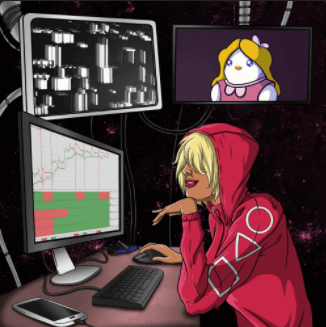Buying This NFT Might Be the Best Investment I’ve Ever Made
This is gonna be legendary.
Several weeks back I wrote to you about my investment in a non-fungible token, or NFT, known as a Shadowy Super Coder. (An NFT is basically a one-off, one-of-a-kind crypto token that can serve as everything from digital art to a keycard providing access to a private website or even a physical building.)
My Shadowy Super Coder NFT looks like this:

Frankly, the art is meaningless. It’s an inside-baseball dig at Sen. Elizabeth Warren, who understands dangerously little about crypto and its underlying technology, blockchain, but who nevertheless spouts off with comments like, “Crypto puts the [banking] system at the whims of some shadowy, faceless group of super coders…”
What’s important about that NFT is what it represents.
Over the course of 2022, everyone who owns one of these NFTs will collect 10,000 cryptocurrency tokens from a blockchain company known as GenesysGO.
GG basically runs back-of-house tasks that are necessary for the Solana network to work. I will not bore you with the technicals. I will only tell you that GenesysGO is a very real company, with a very real business, helping manage Solana—one of the fastest and most popular crypto networks in existence today.
Well, GG launched its initial coin offering on Jan. 3. That’s the blockchain equivalent of an initial public offering on Wall Street, except it involves the rollout of a new cryptocurrency rather than a new stock.
The company’s tokens, traded under the symbol $SHDW (shadow), officially priced at $1.73 at the end of the offering. GenesysGO aimed to raise $15 million in the initial coin offering. Instead, it raised more than $52 million because demand was so high.
However, my cost per token wasn’t $1.73. It was just $0.0575. That’s because I paid only $575 for that NFT when GenesysGO initially unveiled the Shadowy Super Coders back on Nov. 3.
That’s a 2,908% gain in two months.
But I said this is gonna be legendary and, well, a 2,908% gain, while darn nice, is not legendary.
GenesysGO structured its initial offering so that each NFT becomes a digital ATM.
Every day, for one full year—a full 365 days—that NFT is going to spit out 27.39726 $SHDW tokens. At $1.73, that’s $47.40 per day, or roughly $1,500 per month.
Better yet, before the crypto malaise we’ve seen these last few days, $SHDW was trading near $3 (and I’m confident it will return to—then exceed—those levels). Which means the NFT was spinning out more than $82 per day, or between $2,500 and $2,600 per month. That’s $30,000 per year…from a $575 investment…for doing nothing.
But that’s not legendary, either.
Those who stake their NFT—or “deposit” it on the network—for one full year earn a 3,000-token bonus on day 366. At $1.73 per token, that’s another $5,190 payday. At $3, it’s $9,000. At $5, it’s $15,000.
Nice…but even that’s not legendary.
See, GenesysGO has attracted huge dollars from very smart venture capital firms. Those firms invested big in the initial coin offering because they see where GG is headed, not just in terms of strengthening Solana, but in terms of fundamentally changing other blockchains (again, too much tech to spell out here).
Based on competitors—who GenesysGO bests with its technology—this company will be a $2 billion to $10 billion crypto firm. Right now, it’s about $51 million.
Which means $SHDW tokens will be worth somewhere between $10 and $50 each.
Which means the 13,000 tokens locked inside each Shadowy Super Coder NFT are worth somewhere between $130,00 and $650,000 in terminal value.
Now THAT is legendary.
A $575 investment that could generate nearly three-quarters of a million dollars in wealth.
I own 3.5 of those NFTs, meaning an all-in investment of roughly $2,000 could well be worth $1.5 million or more. (By the way, I am not recommending you rush out and buy a Super Coder or the $SHDW token. This is about a bigger message in crypto.)
I know what you’re thinking: Jeff, that’s predicated on a lot of ifs.
Very true.
But not really.
Without diving too deep into the weeds, the Solana blockchain has a weakness dealing with data storage. That weakness limits Solana’s future growth. GenesysGO has figured out an elegant solution to that weakness that basically brings data storage onto the blockchain. Doesn’t sound like much, unless you’re a project developer on Solana…or Solana itself.
Developers have begun raving about GG’s solution. And Solana’s founders are so impressed that one of them changed his Twitter profile to announce that his location is “Shadows.”
Ultimately, I tell you all of this for one reason: Crypto is not singularly the risky, Wild West that the mass media portray it to be.
Yes, risk exists all over the cryptosphere. No doubt. But there are also lots of opportunities such as GenesysGO—real companies, creating real solutions, to real problems, that other real companies need in order to provide even better services to consumers and businesses.
Many of these opportunities still exist.
Many more are going to pop up as we move forward from here.
And like GenesysGO and the Shadowy Super Coders, many are going to be legendary.
Not signed up to Jeff’s Field Notes?
Sign up for FREE by entering your email in the box below and you’ll get his latest insights and analysis delivered direct to your inbox every day (you can unsubscribe at any time). Plus, when you sign up now, you’ll receive a FREE report and bonus video on how to get a second passport. Simply enter your email below to get started.
